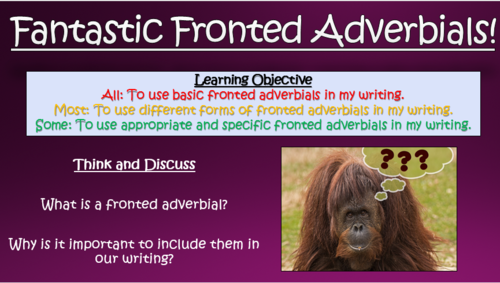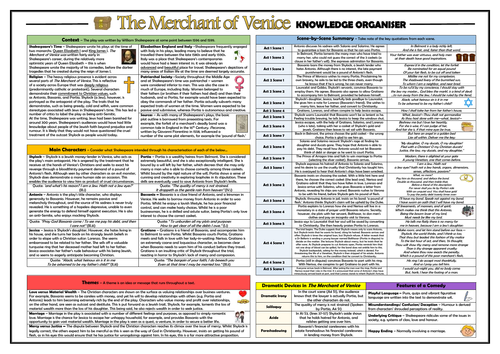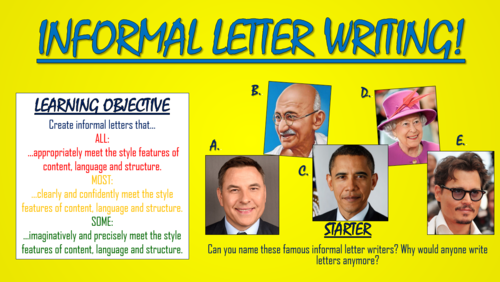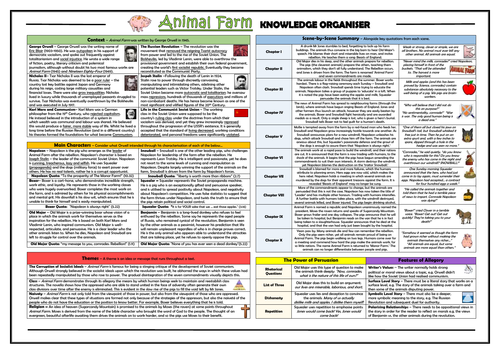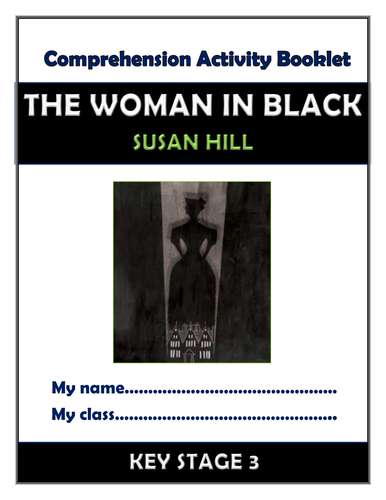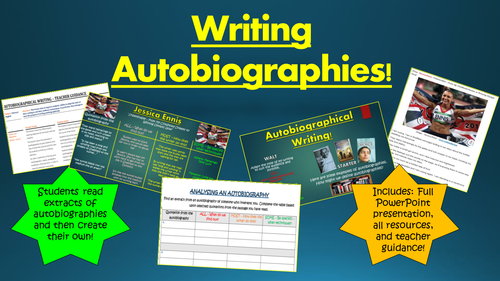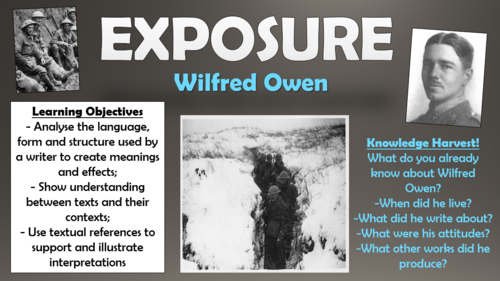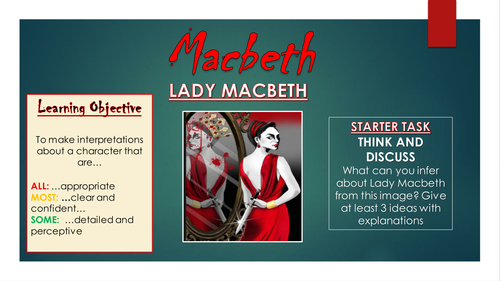
3k+Uploads
1900k+Views
2234k+Downloads
English language arts

Jane Eyre - Bertha Mason: The Gothic Monster!
This engaging and informative lesson enables students to make precise and perceptive interpretations of the character of Bertha Mason in Jane Eyre. Through close analysis of specific extracts from the text, students develop an understanding of how Bertha fits the conventions of a quintessential ‘gothic monster’, and also explore her position as a prime example of the ‘Other’ in Victorian society.
The lesson follows a step-by-step learning journey, in which students learn through:
Defining the key term ‘gothic novel’ and understanding the key conventions of gothic literature;
Reading selected extracts from the text and answering comprehension questions considering Bertha Mason as fulfilling the role of the gothic monster;
Considering ideas of the Victorian ‘Other’ and establishing how Bertha Mason recycles these ideas;
Analysing how ideas of Bertha link to predominant 19th Century ideas about mental health and ethnicity;
Using the knowledge they have gathered over the lesson to design and describe their own gothic monsters;
Peer assessing each other’s learning attempts.
Included is:
Whole lesson PowerPoint - colourful and comprehensive;
Bertha Mason worksheet;
Selected extracts (from chapters 11, 20, and 26);
Character profile template;
Comprehensive lesson plan.
There are also opportunities for group learning, peer assessment, and whole class discussion. These resources were originally taught to GCSE students, but with subtle adaptations they have also been used with both younger and older (up to A Level) students. Worksheets are provided as word docs (so that you can edit) and PDFs (to protect formatting).
All images are licensed for commercial use, and image rights are listed on the last page of the presentation.
Bundle Sale

Northern Lights Big Bundle!
THIS BUNDLE CONTAINS ALL OF THE NORTHERN LIGHTS LESSONS, IN ADDITION TO THE COMPREHENSION BOOKLET AND THE KNOWLEDGE ORGANISER!
This engaging, varied, and informative scheme of learning is designed to help students gain understanding, assessment skills, and key interpretations of Philip Pullman’s ‘Northern Lights.’ Made up of a wide-range of interesting and exciting lessons, students should complete this scheme having gathered vital skills in: interpreting the significant meanings of the text, understanding the writer’s ideas within the text, identifying the traits of key characters, settings, and themes, and understanding structural and language devices.
Stimulating, visual, and easily adaptable, these lessons provide suggested learning objectives and outcomes for students of a wide-range of abilities - The vast majority of tasks are differentiated to allow for different abilities and needs in your classroom. Each lesson loosely follows this logical learning journey to ensure that students learn in bite-size steps:
Engaging
Defining/ Understanding
Identifying/Remembering
Analysing/ Creating
Peer or self evaluating.
All of the lessons are interactive, employ a variety of different teaching and learning methods and styles, and are visually-engaging. Resources, worksheets, and lesson plans are all provided.

Fantastic Fronted Adverbials!
This engaging and detailed resource pack has been designed to make the learning of fronted adverbials (particularly prominent in the new curriculum) easily accessible, engaging and interesting for all children. Throughout the lesson, students learn to improve their skill at using appropriate, concise, and precise fronted adverbials within their own writing compositions. In addition to the comprehensive lesson, resources, and plan, it also includes a fronted adverbials writing mat to assist students in building their extended writing skills.
The lesson follows a clear, logical, bite-size learning journey, which guides students towards differentiated learning objectives. Over the course of this journey, they become able to:
- Define what fronted adverbials are;
- Identify fronted adverbials in sentences;
- Analyse and evaluate what it is that makes some fronted adverbials more effective than others;
- Write an extended piece with the employment of fronted adverbials;
-Peer/self-assess learning attempts.
This resource pack includes:
- A visually engaging whole-lesson PowerPoint presentation;
- A clear and interesting worksheet for the development task;
- An interesting short story for students to analyse;
- A hyperlink to an engaging and heart-warming video through a hyperlink in the presentation;
- A detailed lesson plan, complete with what the teacher and students should aim to achieve at each stage of the lesson.
All images are licensed for commercial use, and are cited on the final slide of the PowerPoint/ the bottom of worksheets.

The Merchant of Venice Knowledge Organiser/ Revision Mat!
This detailed and visually-appealing resource offers a complete reference point for students learning or revising William Shakespeare’s ‘The Merchant of Venice.’ It contains comprehensive sections on:
Context;
Scene by Scene Summary (with quotes);
Main Characters;
Themes;
Dramatic Devices;
Features of Comedy.
Key words and ideas are underlined for easy reference. The resource is designed to be printed onto A3, and is provided as both a PDF and a Word version (so that you can edit if you want to). All images used are licensed for commercial use and are cited on a separate document (included).

Pigeon English - Knowledge Organiser/ Revision Mat!
This detailed and visually-appealing resource offers a complete reference point for students learning or revising Stephen Kelman’s ‘Pigeon English.’ It contains comprehensive sections on:
Context;
Chapter by Chapter Summary (with quotes);
Main Characters;
Themes;
Symbols and Motifs;
Key Terminology Definitions.
Key words and ideas are underlined for easy reference. The resource is designed to be printed onto A3, and is provided as both a PDF and a Word version (so that you can edit if you want to). All images used are licensed for commercial use and are cited on a separate document (included).

Informal Letter Writing!
This stimulating and informative lesson develops students’ skill in creating informal letters that precisely meet the content, language and structural features of the form. In particular, they gain an in-depth understanding of how informal letters should be set out on the page, what information should be included within them, and what style they should be written in, in order to meet form, audience and purpose.
Students follow a clear and logical learning journey, in which they:
-Understand why letter writing is still important in the present day;
-Unjumble a model example of an informal letter in order to establish its structure;
-Work collaboratively to identify and analyse the content and language features in further model examples of informal letters;
-Create a success criteria for effective informal letters (although a ready-made success criteria is included);
-Write their own informal letters, using a structure strip and helpsheet (if needed) and the techniques that they have learnt;
-Peer/self-assess their writing attempts.
There are enough resources here really for two lessons, including:
-Visually engaging whole-lesson PowerPoint;
-Informal letters x 3 (based on The Simpsons, Batman, and Harry Potter characters)
-Informal letters structure strip;
-Informal letters helpsheet;
-Step-by-step lesson plan.
All images are licensed for commercial use, and are cited on the final page of the slide.

Animal Farm Knowledge Organiser/ Revision Mat!
This detailed and visually-appealing resource offers a complete reference point for students learning or revising George Orwell's 'Animal Farm.' It contains comprehensive sections on:
- Context;
- Chapter by Chapter Summary (with quotes);
- Main Characters;
- Themes;
- Features of Allegory;
- 'The Power of Persuasion (in the speeches of Old Major and Squealer).
Key words and ideas are underlined for easy reference. The resource is designed to be printed onto A3, and is provided as both a PDF and a Word version (so that you can edit if you want to). All images used are licensed for commercial use and are cited on a separate document (included).

The Woman in Black - KS3 Comprehension Activities Booklet!
This resource booklet contains a wide range of age-appropriate, engaging, and meaningful comprehension activities for use throughout the reading of Susan Hill's 'The Woman in Black.' Teachers have found them particularly useful in comprehension or guided reading sessions. They are perfect for aiding the progress of children towards meeting the KS3 expectations within the new National Curriculum framework. Children have found these resources extremely engaging, and for teachers there is explicit information within each task regarding which comprehension strands the task is designed to demonstrate. They also relate to key extracts, characters, and themes from the story, ensuring that children gain a deep understanding of the text.
Activities within the booklet include:
- 'Context: The Rural North' - to enable students to demonstrate that they can: 'Know the purpose, audience and context of the writing and drawing on this knowledge to support comprehension.'
- 'Hill's Description - The Horse and Trap' - to enable students to demonstrate that they can: 'Know how language, including figurative language, vocabulary choice, grammar, text structure and organisational features, present meaning.'
- 'Mr Jerome' and 'The Woman in Black' - to enable students to demonstrate that they can: 'Study setting, plot, and characterisation, and the effects of these.'
- 'Vocabulary Inspector' - to enable students to demonstrate that they can: 'Learn new vocabulary, relating it explicitly to known vocabulary and understanding it with the help of context and dictionaries.'
Plus many, many more activities (the booklet is 21 pages in length!) I've also added it as a PDF in case the formatting differs on your computer.
All images are licensed for commercial use, and are cited on a separate document (included).

Writing Autobiographies!
This stimulating and informative lesson aims to improve students’ ability to adapt the style of their writing to suit their audience and purpose. In particular, they attempt to meet the purpose of writing autobiographically.
Students follow a clear and logical learning journey, in which they:
-Define autobiographies and their key features;
-Read extracts of autobiographies, and analyse the language techniques used;
-Use independent learning skills to analyse an autobiography of their choice;
-Create a success criteria for effective autobiography writing (although a ready-made success criteria is included)
-Write a section of their own autobiography, using the techniques that they have learnt;
-Peer/self-assess their autobiographical attempts.
There are enough resources here really for two lessons, including:
-Visually engaging whole-lesson PowerPoint;
-Autobiography extract;
-Analysing Autobiographies template;
-Success Criteria;
-Step-by-step lesson plan.
All images are licensed for commercial use, and are cited on the final page of the slide.

Writing Recounts - Lower KS2 Knowledge Organiser!
This clear, detailed and visually-appealing resource offers a complete reference point for year 3-4 children when writing recounts. The organiser is also perfect for teachers, parents and English subject leaders - aiding their planning and supporting of children’s knowledge development for this writing text type.
The organiser has a particular focus on the content, language and structural features required to write effective mystery stories at lower KS2. It contains distinct sections covering:
-Recounts Overview;
-Content: Settings, Characters, and Plot;
-Language: Descriptive Devices, Dialogue, Conjunctions, Punctuation Checklist and Word Mat;
-Structure - Titles, Planning Techniques and other tips;
-Key Vocabulary
The content is fully aligned with the age-related expectations for Lower KS2 children in writing. The resource is designed to be printed onto A3, and is provided as both a PDF and a Word version (so that you can edit if you want to).

Pointless - Template to Create Your Own Games!
Template for you to create your own Pointless games - whatever subject or topic you are teaching!
Based on the popular game show 'Pointless', this resource is perfect for use as a starter activity, plenary, or revision tool. Editable, so that you can change to any other topic or change the questions/answers. Containing almost 30 slides of sound clips, engaging visuals, and suitably challenging questions, this resource is effective at both promoting engagement and enhancing learning.
There are several built-in rounds of questions to build students' understanding in your topics, including:
- Identifying terms from definitions
- Anagrams of key terms round
- Recalling the highest level knowledge.
The nature of the game ensures that this resource can challenge students of all levels.
NOTE: You can buy this resource alone, or in a bundle of 8 Pointless games, for only £1 more!

Tissue - Imtiaz Dharker - Knowledge Organiser/ Revision Mat!
This detailed and visually-appealing resource offers a complete reference point for students learning or revising Imtiaz Dharker’s power and conflict poem 'Tissue.’ It contains comprehensive sections on:
Context;
Line-by-Line Analysis;
Poetic Devices/ Language Devices;
Themes;
Form/Structure;
Poems for Comparison;
The Poet’s Influences.
Key words and ideas are underlined for easy reference. The resource is designed to be printed onto A3, and is provided as both a PDF and a Word version (so that you can edit if you want to). All images used are licensed for commercial use and are cited on a separate document (included).
Bundle Sale

Power and Conflict Poetry Knowledge Organisers Huge Bundle!
THIS BUNDLE CONTAINS KNOWLEDGE ORGANISERS FOR ALL 15 OF THE POWER AND CONFLICT POEMS!
These clear, detailed and visually-appealing knowledge organisers offer complete reference points for students learning or revising the following poems from the ‘Power and Conflict’ anthology:
Exposure - Wilfred Owen;
Bayonet Charge - Ted Hughes;
The Charge of the Light Brigade - Alfred, Lord Tennyson;
Poppies - Jane Weir
War Photographer - Carol Ann Duffy
Kamikaze - Beatrice Garland
Ozymandias - Percy Bysshe Shelley
My Last Duchess - Robert Browning
Storm on the Island - Seamus Heaney
Checking Out Me History - John Agard
Tissue - Imtiaz Dharker
Remains - Simon Armitage
The Prelude (Extract) - William Wordsworth
The Emigree - Carol Rumens
London - William Blake
Each organiser contains a number of detailed, clear, and colourful sections explaining the key elements of the poem:
Context;
Line-by-Line Analysis;
Poetic Devices/ Language Devices;
Themes;
Form/Structure;
Poems for Comparison;
The Poet’s Influences.
The resources are designed to be printed onto A3, and are provided as both PDFs and Word documents (so that you can edit should you wish to). All images used are licensed for commercial use and are cited on a separate document (included).
Bundle Sale

Julius Caesar - William Shakespeare - Big Bundle!
THIS BUNDLE CONTAINS ALL OF THE JULIUS CAESAR LESSONS, IN ADDITION TO THE COMPREHENSION ACTIVITY BOOKLET, AND THE JULIUS CAESAR KNOWLEDGE ORGANISER!
This engaging, varied, and informative scheme of learning is designed to help students gain understanding, assessment skills, and key interpretations of William Shakespeare’s ‘Julius Caesar.’ Made up of a wide-range of interesting and exciting lessons, students should complete this scheme having gathered vital skills in: interpreting the significant meanings of the play, understanding the writer’s ideas within the play, analysing key characters, settings, and themes, and understanding Shakespeare’s language devices.
Included is:
Julius Caesar Knowledge Organiser
Julius Caesar Comprehension Bundle
…and the lessons…
-Understanding Historical Context;
-Act 1 Scene 1 - The Play Opening;
-Act 1 Scene 2 - The Feast of Lupercal;
-Act 3 Scene 1 - The Assassination Scene;
-Act 3 Scene 2 - Mark Antony’s Speech;
-Act 4 Scene 3 - The Ghost of Caesar;
-Act 5 Scene 5 - Brutus: The Tragic Hero.
Stimulating, visual, and easily adaptable, these lessons provide suggested learning objectives and outcomes for students of a wide-range of abilities - The vast majority of tasks are differentiated to allow for different abilities and needs in your classroom. Each lesson loosely follows this logical learning journey to ensure that students learn in bite-size steps:
Engaging
Defining/ Understanding
Identifying/Remembering
Analysing/ Creating
Peer or self evaluating.
All of the lessons are interactive, employ a variety of different teaching and learning methods and styles, and are visually-engaging. Resources, worksheets, and lesson plans are all provided.
Bundle Sale

Rooftoppers - Big Bundle!
This ‘Rooftoppers’ bundle contains all of the ‘Rooftoppers’ lessons, the detailed knowledge organiser, and the 22-page comprehension activity booklet.
The engaging and thought-provoking series of lessons has been devised to provide students with a well-rounded, secure understanding of the text. Ten resource sets are included, each of which will take approximately 2-3 lessons to deliver.
Chapters 1-3
Chapters 4-6
Chapters 7-9
Chapters 10-12
Chapters 13-15
Chapters 16-18
Chapters 19-21
Chapters 22-25
Chapters 26-28
Chapters 29-31
The comprehensive and colourful PowerPoint presentations guide students through a wide range of activities, including those designed to enhance the following skills: retrieval, understanding vocabulary, inference, explanation, summarising, sequencing, analysis and deeper thinking activities. Additional worksheets and templates are also provided where needed for some of the creative tasks.
All of the resources and tried and tested in real classrooms, catalysing excellent outcomes. The resources are suitable for students across KS2 (I originally used them with year 5 and 6 classes).

The Merchant of Venice - Act 4 Scene 1 - The Courtroom Scene!
This engaging and informative lesson enables students to make clear, detailed and well-informed interpretations of Act IV Scene I of The Merchant of Venice. In particular, students develop their understanding of the key events/ implications of the scene, identify and analyse the language devices used by Shakespeare within key quotations from the scene, and consider the effect of these choices on Shakespearean audiences.
The lesson follows a step-by-step learning journey, in which children learn through:
Engage with an artist’s impression of the courtroom scene, honing their skills of inference and deduction;
Reading and comprehending the main events and meanings in the courtroom scene;
Identifying and analysing Shakespeare’s use of language through examples of Portia and Shylock lines in the scene;
Considering Shakespeare’s intentions and the Shakespearean audiences reactions to the scene;
Self assessing their learning through the lesson;
Included is:
Whole lesson PowerPoint - colourful and comprehensive;
Language devices cards for the card-sorting activity;
Key quotations cards;
Copy of Act IV Scene I;
Shakespeare’s Intentions/ Audience Reactions template;
Comprehensive lesson plan.
Resources are provided in PDF (to maintain formatting), Word (so that they are easily editable) and also in zipfiles.
The lesson contains opportunities for group learning, speaking and listening, peer assessment, and whole class discussion. I originally used these resources with year 10 and 11 classes, however colleagues have used them for between year 9 and year 13 with some adaptations.
All images are licensed for commercial use, and image rights are listed on the last page of the presentation.

Travel Writing: Constructing Imaginative Language
This engaging and stimulating lesson enables students to create travel writing texts containing appropriate and imaginative language choices, utilising a range of different language techniques with subtlety in order to craft vivid and thought-provoking writing. In particular, students learn how the subtle use of varied verbs, adverbs, and adjectives, in addition to descriptive devices such as similes, metaphors, and personification, can help to create truly authentic and descriptive travel writing pieces.
The lesson follows a clear, logical, bite-size learning journey, which guides students towards differentiated learning objectives. Over the course of this journey, they become able to:
- Define and identify verbs, adverbs, and adjectives, and understand the effects of varying these basic sentence building blocks;
- Employ appropriate and imaginative verbs, adverbs, and adjectives to describe a range of travel images;
- Understand and analyse how more advanced descriptive devices (similes, metaphors, personification, alliteration, and assonance) influence the effect of writing;
- Analyse a model travel writing attempt in relation to language features, before creating their own;
- Self/Peer assess travel writing attempts.
This resource pack includes:
- A visually engaging whole-lesson PowerPoint presentation;
- An interesting and ambitious travel writing extract (with a highlighted version for teachers):
-A logical and challenging worksheet, encouraging students to identify and analyse;
- A detailed lesson plan, complete with what the teacher and students should aim to achieve at each stage of the lesson.
All images are licensed for commercial use, and are cited on the final slide of the PowerPoint.

Similes and Metaphors in Popular Music!
This interesting and highly stimulating lesson enables students to demonstrate a developed and sustained understanding of the effect of figurative language in popular music texts. In particular, students learn to explore the meanings behind similes and metaphors across songs from a range of genres, considering the effect upon the whole text and the intended audience. As one would expect, Students love learning about similes and metaphors through popular music, and this lesson can really help to open students' eyes to how language can be crafted for effect. This has numerous benefits in later poetry and descriptive writing lessons.
The lesson follows a clear, logical, bite-size learning journey, which guides students towards differentiated learning objectives. Over the course of this journey, they become able to:
- Define and identify similes and metaphors;
- Explain the similarities and differences between songs and poetry;
- Observe and listen to several examples of similes and metaphors in popular music examples;
- Understand and analyse the effect of similes and metaphors upon meanings and the reader;
- Apply their knowledge of why similes and metaphors are used to a range of contexts and musical genres;
- Collaborate and present their key findings about similes and metaphors in songs to their classmates;
- Self-assess their learning attempts.
This resource pack includes:
- A visually engaging whole-lesson PowerPoint presentation;
- Link to an online compilation video of similes and metaphors in popular music;
- 3 x lyrics analysis worksheets of varying difficulties (Katy Perry, Train, and Florence and the Machine - all clean)
- A detailed lesson plan, complete with what the teacher and students should aim to achieve at each stage of the lesson.
All images are licensed for commercial use, and are cited on the final slide of the PowerPoint.

Exposure - Wilfred Owen
This engaging, comprehensive lesson aims to improve students’ understanding of Wilfred Owen’s WWI power and conflict poem ‘Exposure’ with particular focus upon the language, structure, and subject matter used within the poem. By the end of the lesson, students demonstrate their knowledge of the text analytically, through assured, appropriate, and sustained interpretations.
The lesson follows a step-by-step learning journey, in which children learn through:
Considering the meanings of the word ‘exposure’ and inferring what this may suggest about the meaning of the poem;
Securing contextual understanding of the conditions and weather faced by WWI soldiers;
Reading and interpreting the poem, using a provided line-by-line analysis, and interactive group activities;
Developing their understanding through inferring and analysing key language and structural choices;
Analysing how the themes of suffering and misery are conveyed through Owen’s language and structure choices;
Self/ Peer assessing each other’s learning attempts.
Included is:
Whole lesson PowerPoint - colourful and substantial; (including hyperlinks to informative and videos)
Copy of poem (freely available online);
Deeper thinking worksheet;
Analysis template with success criteria for creating well-structured responses;
Comprehensive lesson plan.
All resources are provided as word documents (for easy editing) and PDF documents (to ensure consistency of formatting between computers).
There are also opportunities for group learning, peer assessment, and whole class discussion. This was originally taught to middle-ability year 10 and 11 groups, but can easily be differentiated for groups of different ages and abilities.
All images are licensed for commercial use, and image rights are listed on the last page of the presentation.

Macbeth: Lady Macbeth
This engaging and interesting lesson aims to improve students’ understanding of one of the key characters in William Shakespeare’s Macbeth: Lady Macbeth. In particular, they learn to make insightful interpretations about the character, and are enabled to draw links between Lady Macbeth and their knowledge of women in Shakespearean times.
The lesson utilises a range of tasks, that require students to be visual and interactive learners. It follows this learning journey:
- Inferring key information about the character of Lady Macbeth from picture clues;
- Identifying and ordering the key events in the text in which Lady Macbeth is involved;
- Understanding her role in the rise and downfall of Macbeth;
- Comparing and contrasting between her character and the expected role of women at the time the play was written;
- Analysing Shakespeare's development of Lady Macbeth as a key character throughout the text;
- Evaluating the learning in the lesson.
Included in this resource pack are:
- A well-presented, thorough, and informative, whole-lesson PowerPoint presentation;
- Resources for the sequencing activity, detailing Lady Macbeth's numerous actions throughout the play;
- A template to help scaffold the main task, complete with P.E.E instructions;
- A comprehensive teacher guidance form/lesson plan to assist delivery.
All images in this resource are licensed for commercial use, and are cited on the final slide of the lesson presentation.



